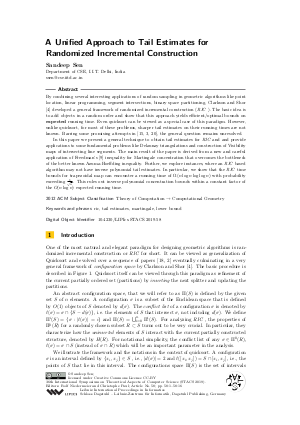A Unified Approach to Tail Estimates for Randomized Incremental Construction
Author Sandeep Sen
-
Part of:
Volume:
36th International Symposium on Theoretical Aspects of Computer Science (STACS 2019)
Part of: Series: Leibniz International Proceedings in Informatics (LIPIcs)
Part of: Conference: Symposium on Theoretical Aspects of Computer Science (STACS) - License:
 Creative Commons Attribution 3.0 Unported license
Creative Commons Attribution 3.0 Unported license
- Publication Date: 2019-03-12
File

PDF
LIPIcs.STACS.2019.58.pdf
- Filesize: 0.71 MB
- 16 pages
Document Identifiers
Subject Classification
ACM Subject Classification
- Theory of computation → Computational geometry
Keywords
- ric
- tail estimates
- martingale
- lower bound
Metrics
- Access Statistics
-
Total Accesses (updated on a weekly basis)
0Document
0Metadata
Abstract
By combining several interesting applications of random sampling in geometric algorithms like point location, linear programming, segment intersections, binary space partitioning, Clarkson and Shor [Kenneth L. Clarkson and Peter W. Shor, 1989] developed a general framework of randomized incremental construction (RIC ). The basic idea is to add objects in a random order and show that this approach yields efficient/optimal bounds on expected running time. Even quicksort can be viewed as a special case of this paradigm. However, unlike quicksort, for most of these problems, sharper tail estimates on their running times are not known. Barring some promising attempts in [Kurt Mehlhorn et al., 1993; Kenneth L. Clarkson et al., 1992; Raimund Seidel, 1991], the general question remains unresolved.
In this paper we present a general technique to obtain tail estimates for RIC and and provide applications to some fundamental problems like Delaunay triangulations and construction of Visibility maps of intersecting line segments. The main result of the paper is derived from a new and careful application of Freedman’s [David Freedman, 1975] inequality for Martingale concentration that overcomes the bottleneck of the better known Azuma-Hoeffding inequality. Further, we explore instances, where an RIC based algorithm may not have inverse polynomial tail estimates. In particular, we show that the RIC time bounds for trapezoidal map can encounter a running time of Omega (n log n log log n) with probability exceeding 1/(sqrt{n)}. This rules out inverse polynomial concentration bounds within a constant factor of the O(n log n) expected running time.
Cite As Get BibTex
Sandeep Sen. A Unified Approach to Tail Estimates for Randomized Incremental Construction. In 36th International Symposium on Theoretical Aspects of Computer Science (STACS 2019). Leibniz International Proceedings in Informatics (LIPIcs), Volume 126, pp. 58:1-58:16, Schloss Dagstuhl – Leibniz-Zentrum für Informatik (2019)
https://doi.org/10.4230/LIPIcs.STACS.2019.58
BibTex
@InProceedings{sen:LIPIcs.STACS.2019.58,
author = {Sen, Sandeep},
title = {{A Unified Approach to Tail Estimates for Randomized Incremental Construction}},
booktitle = {36th International Symposium on Theoretical Aspects of Computer Science (STACS 2019)},
pages = {58:1--58:16},
series = {Leibniz International Proceedings in Informatics (LIPIcs)},
ISBN = {978-3-95977-100-9},
ISSN = {1868-8969},
year = {2019},
volume = {126},
editor = {Niedermeier, Rolf and Paul, Christophe},
publisher = {Schloss Dagstuhl -- Leibniz-Zentrum f{\"u}r Informatik},
address = {Dagstuhl, Germany},
URL = {https://drops.dagstuhl.de/entities/document/10.4230/LIPIcs.STACS.2019.58},
URN = {urn:nbn:de:0030-drops-102977},
doi = {10.4230/LIPIcs.STACS.2019.58},
annote = {Keywords: ric, tail estimates, martingale, lower bound}
}
Author Details
References
-
P. Chew. The simplest Voronoi diagram algorithm takes linear expected time. In Manuscript, 1988.

-
Kenneth L. Clarkson. Applications of Random Sampling in Computational Geometry, II. In Symposium on Computational Geometry, pages 1-11. ACM, 1988.

-
Kenneth L. Clarkson, Kurt Mehlhorn, and Raimund Seidel. Four Results on Randomized Incremental Constructions. In STACS 92, 9th Annual Symposium on Theoretical Aspects of Computer Science, Cachan, France, February 13-15, 1992, Proceedings, pages 463-474, 1992.

-
Kenneth L. Clarkson and Peter W. Shor. Application of Random Sampling in Computational Geometry, II. Discrete & Computational Geometry, 4:387-421, 1989.

-
J.L. Doob. Regularity properties of certain families of chance variables. Transactions of the American Mathematical Society, 47 (3):455–-486, 1940.

-
Devdatt P. Dubhashi and Alessandro Panconesi. Concentration of Measure for the Analysis of Randomized Algorithms. Cambridge University Press, 2009.

-
W. Feller. An Introduction to Probability Theory, Vol. 1. Wiley, New York, NY, third edition, 1968.

-
W. Feller. An Introduction to Probability Theory and Its Applications, Vol. 2. Wiley, New York, NY, second edition, 1971.

-
David Freedman. On tail probabilities on martingales. In The Annals of Probability, volume 3(1), pages 100-118, 1975.

-
Leonidas J. Guibas, Donald E. Knuth, and Micha Sharir. Randomized Incremental Construction of Delaunay and Voronoi Diagrams. Algorithmica, 7(4):381-413, 1992.

-
David Haussler and Emo Welzl. Epsilon-Nets and Simplex Range Queries. In Proceedings of the Second Annual ACM SIGACT/SIGGRAPH Symposium on Computational Geometry, Yorktown Heights, NY, USA, June 2-4, 1986, pages 61-71, 1986.

-
S. Khuller and Y. Matias. A Simple Randomized Sieve Algorithm for the Closest-Pair Problem. Information and Computation, 118(1):34-37, 1995.

-
C. McDiarmid. Concentration. Probabilistic Methods for Algorithmic Discrete Mathematics, 16, Algorithms and Combinatorics:195–-248, 1998.

-
Colin McDiarmid and Ryan Hayward. Large Deviations for Quicksort. J. Algorithms, 21(3):476-507, 1996.

-
Kurt Mehlhorn, Micha Sharir, and Emo Welzl. Tail Estimates for the Efficiency of Randomized Incremental Algorithms for Line Segment Intersection. Comput. Geom., 3:235-246, 1993.

-
Rajeev Motwani and Prabhakar Raghavan. Randomized Algorithms. Cambridge University Press, New York, NY, USA, 1995.

- K. Mulmuley. Computational Geometry: An Introduction Through Randomized Algorithms. Prentice-Hall, 1994. URL: https://books.google.com/books?id=rjgZAQAAIAAJ.
-
Ketan Mulmuley. A Fast Planar Partition Algorithm, I (Extended Abstract). In 29th Annual Symposium on Foundations of Computer Science, White Plains, New York, USA, 24-26 October 1988, pages 580-589, 1988.

-
Raimund Seidel. A Simple and Fast Incremental Randomized Algorithm for Computing Trapezoidal Decompositions and for Triangulating Polygons. Comput. Geom., 1:51-64, 1991.

-
Raimund Seidel. Small-Dimensional Linear Programming and Convex Hulls Made Easy. Discrete & Computational Geometry, 6:423-434, 1991.

-
Raimund Seidel. Backwards Analysis of Randomized Geometric Algorithms. In In: Pach J. (eds) New Trends in Discrete and Computational Geometry. Algorithms and Combinatorics, volume 10. Springer, Berlin, Heidelberg, 1993.

